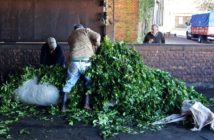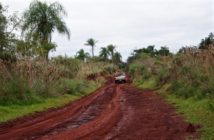The following piece is the final installment that sheds light on the production of Yerba Mate and its cultural and economic impacts of Argentina, Paraguay, and Uruguay by Klas Lundstrom.
Don’t miss out – catch up on part one and part two.
A single lamp dangles from the high ceiling in the plantation house’s saloon, and smears light on the mansion’s deep-brown walls. The night is quiet, and two Núñez siblings are having dinner. The farmer and the family accountant discuss work. The Núñez family can boast an annual maté production of 30 tonnes, but that is a modest yearly harvest in comparison to the industry’s big guns. The number one producer, Las Marías, produce 65,000 tonnes every year.
But it must never be a question of quantity, Ricardo Núñez explains as he takes a sip of his red wine. “We see over-production, and therefore the main question is how much maté the industry can bear. How we – and whom – will consume yerba maté in the future, remains to be seen.”
In the 1990s, the industry was plagued by crisis and scandals. Pests were wreaking havoc on plantation trunks and farmers introduced pesticides on a large scale. This has upset a balance with nature and put the industry at a crossroads.
“It’s about choices now,” says Ricardo. “You either add pesticides and squeeze out the maximum of each harvest at the expense of the soil’s well-being, or you dare to be patient and let the trees live their own lives in harmony with the soil, without manipulating the production with toxic additives. Sure, you produce less and you better be prepared for long periods of time waiting to be able to harvest again, but you can await a tomorrow with sustainable production.”
Most small-scale producers in Misiones, he says, choose to be patient.
***
In the forests of Treinta y Tres, a sparsely populated department in rural eastern Uruguay, one hears whispers of ecological treasures, lost during the colonial era, being found in the wild again.
One of those treasures is free-growing yerba maté.
It may also be the case that these treasures were never truly lost because they had never been found. No one had ever explored the wilderness, not really. Not like Alberto Demicheli, founder and administrator of Caa Porá plantation in Quebrada Valley, and grandson of Alberto Demicheli Sr., Uruguay’s de facto President for a short stint in 1976. Back then, Uruguay was a military dictatorship ruled by the Colorado Party, and President Demicheli was shortly ousted due to his “liberal leanings.”
“Mind your step, it’s easy to forget that this is a forest.”
For someone whose name always will be linked to a sad and brutal past, the forests and wilderness of the Quebrada Valley have always been Alberto’s sanctuary. He is the sole person, other than the Forest Department, to have access to a large portion of this wilderness. At the brink of dusk, after a long day’s drive from the country’s capital of Montevideo, followed by another hour along steep gravel roads, at times no more than scars in the ground, Albert arrives home.
He parks in front of his hut at the heart of the family land and kills the engine. He gets out of the car and breathes the fresh air. His shirt is stained by dust and gravel. Now, with little over an hour of daylight left, he’s determined to make the most of it. He normally spends most of his time sailing from different ports across the vast emptiness of the Atlantic Ocean, but it is here in the Uruguayan wild forests that his heart truly lies. It’s here where his life’s project takes place.
And it’s also where his steps lead him – into the forest.
It all started in 2002, the year when Alberto Demicheli became a pioneer in a country whose maté consumption per capita is the highest in the world – but without its own production, and thus dependent on neighboring countries, mainly Brazil.
“Why doesn’t Uruguay, the country that consumes the most maté in the world per capita, produce its own? Ninety percent is imported from Brazil, the rest from Argentina.”
It simply isn’t doable, has been the recurring chorus. This song has been sung not only from the country’s influential agriculture and cattle industry but from Uruguayan politicians – among them ex-President José “Pepe” Mujica. This is why the Uruguayan maté’s unsung pioneer turned out to be a sailor who picked up on a rumor he heard back in the 1990s.
“I heard about maté trees growing wild around in Uruguay, and became curious,” says Alberto. “So, I started to do a little travel around, investigating the matter.”
Fifteen years and numerous days of travel along the Uruguayan countryside later, 1,450 trees of yerba maté now grow in Quebrada Valley’s vast and leafy forests. These trees grow from seeds Alberto planted in suitable forest spots. He emphasizes that wild-growing maté trees have been here for decades, perhaps even for centuries, without public knowledge. They’ve been left alone in the soil to stretch out and reach for the sky above the thick shrubbery.
“But remember,” he says, “this is not a maté plantation, nor is it a project funded by any commercial or scientific interests.”
It is a mere walk in the forest, listening to a sailor’s story.
“Most Uruguayan believe and are led to think, that we neither have the climate nor the capacity to pull off our own maté production. That’s what we’ve been told for a long time since loggers and the timber industry nearly destroyed Uruguay’s natural fauna. But, as you can see, there are still traces of untouched landscape left, and I’ve talked to people all over Uruguay who’ve either seen wild-growing maté trees or have managed to plant some in their own backyards. So, you might say that I just want to prove that it’s possible to cultivate maté, plain and simple.”
The maté trees thrive in “La Quebrada,” but it is still to be seen whether it would be possible to sustain nationwide production sufficient to serve Uruguay’s two million consumers. Eucalyptus for pulp takes up much of the suitable land, but with unfortunate effects on the environment and groundwater aquifers. There is also the question of whether a domestic investment in a large-scale maté industry would endanger the nation’s relationship with Brazil, whose southern states’ economies are tied up with the “Paraguayan tea,” the name Spanish Conquistadores long ago gave the beverage.
Maté began its extraordinary journey as a local sacred beverage, served only by semi-nomadic Guaraní tribes who held closely the mysteries of cultivating the seeds. It became a tool in the Spanish and Portuguese colonization of South America, leading to its modern-day status as an economic cornerstone of the economies of Argentina, Brazil, and Paraguay. Its potential as an instrument of political pressure has not been forgotten.
The maté tree’s ability to grow in “La Quebrada” has seen many visitors to the forest throughout the years, and many more are expected to come. Argentine scientists, Brazilian investors, and small-scale Uruguayan maté farmers are all bewildered by Alberto’s achievement.
The mystery of the forest, of Caa Porá, embodies the mystery of yerba maté itself. A man with a machete wandering through a forest puts all life on high alert.
“And that’s the way it should be,” says Alberto, and stops by a two-headed, thick tree trunk. He smiles and recalls what happened here – “right here” – a few years ago.
As of now, it was dusk.
“I was dead-tired after an entire day out in the forest, harvesting maté leaves and clearing up passages. I sat down for a smoke and some air, I was on my way back up to the house, and leaned my back against this beautiful trunk – and fell asleep. I woke up when a wild boar tried to remove my shoe, intending to feast on my foot. I literally jumped up screaming, and took refuge in this very tree – and the boar ran away, frightened by my sudden moves.”
Alberto pauses and looks to his left, where a passage has sprung up in the shape of a natural tunnel. “This is the core of La Quebrada,” he says. “Any human being that comes here has to realize that he or she is just one of many living things.”
***
Darkness has swept its blanket over the forest when Alberto opens the door to his hut. He pours water into a kettle and fills the stove with wooden stickers. He then collects a bag of four-year-old maté; picked, heated, dried, and stored in his hut built and inspired by Guaraní custom. Its tipi architecture welcomes the coming of the night and the living beings that springs to life with it.
Alberto organizes a circle and passes the gourd and bombilla around. The Guaraní custom is to use the maté circle as a gateway to talks and company. In the morning, one can share dreams; in the evening, after dark, the events of the day. The silence settles, the sounds and echoes of the world outside of the hut form shapes of organic symphonies. Vapor from the maté gourd sails through the damp indoor air. A scent of burning wood and watered yerba maté.
The aroma of life.
About the author:
Klas Lundstrom (b. 1982) is a self-taught writer and journalist based in Stockholm, Sweden. He started writing as an eleven-year-old trying to cope with the death of his father. Author of numerous nonfiction books on, e.g., the U.S. uranium industry and its social and environmental impacts, Latin America’s forgotten regions, and East Timor’s walk from Indonesian occupation to U.N. colony. As a reporter, he has contributed numerous media outlets throughout the years, e.g. The Guardian, The Jakarta Post, and TT, Sweden’s equivalent to Associated Press. He has lived in both Brazil and Uruguay and is a dedicated yerba maté consumer and hopes that his reporting on the maté industry can help other consumers understanding the business, and thus make more ethical and aware choices regarding products, companies, and origin.
Learn more about Klas Lundstrom, and follow him on Twitter.



